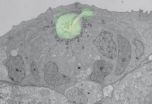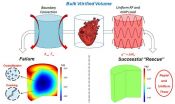(Press-News.org) From basketball to handball, rugby to American football, teams in a variety of sports huddle together to agree tactics in secret. Cells, too, can huddle to communicate within a restricted group, scientists at the European Molecular Biology Laboratory (EMBL) in Heidelberg, Germany, have found. The study, published today in Nature, is the first demonstration that the way cells organise themselves influences their ability to communicate. The researchers propose that this strategy, which they discovered in developing zebrafish, could be much more widespread, influencing processes like wound repair, organ formation and even cancer.
"Everybody can speak, everybody can listen, but what's said in the group stays in the group," explains Sevi Durdu, who carried out the research, "by huddling together, these cells trap and concentrate a signal to communicate only amongst themselves."
Durdu, a PhD student in Darren Gilmour's lab at EMBL, found this behaviour in specific groups of cells in the zebrafish: the cells that will develop into the animal's 'lateral line', a series of ear-like organs along the fish's flank that allow it to sense changes in water pressure. As a zebrafish develops, a mass of cells moves along the developing animal's side. At the point where one of these organs should form, a group of cells at the rear assembles into a huddle and stops, eventually developing into the organ. The rest of the cells, meanwhile, have moved on, until another group stops to form another organ, and so on. The cells that group together and stop to form the future organ also change shape, going from flat, crawling cells to upright, tear-shaped cells that come together like cloves in a bulb of garlic. Durdu found that these 'garlic cloves' huddle around a shared space, or lumen, in which they trap a molecule cells use to communicate: FGF.
"Normally, FGF acts as a long-range communication signal. In the lateral line, we find that most of this signal is normally just wafting over the cells' heads," says Gilmour. "But when cells get together and huddle they can trap and concentrate this signal in their shared lumen, and make a decision that the others can't: they stop moving."
The EMBL scientists found that, by enabling a group of cells to increase the concentration of FGF they are in contact with, the shared lumen plays a critical role in determining when and where the huddles stop moving. When the scientists increased the concentration of FGF, cell huddles came to a standstill more abruptly, forming organs that were closer together. And when they decreased the level of FGF, huddles continued to migrate for longer and formed organs that were further apart.
"All epithelial cells – and that's the cells that make up most of the organs in our bodies – can do this, so you could imagine that this type of local chamber could be forming transiently in many different parts of the body, whenever cells need to self-organise and communicate," Gilmour says.
When the scientists broke up cell huddles in their zebrafish embryos, FGF leaked out. When this happens the cells in a group are no longer able to communicate efficiently, leading the scientists to wonder if this influence of organisation on communication could play a role in wound repair. When our skin is scratched, cells that were standing upright 'lie down' and start crawling – in essence, local huddles break up and cells change their behaviour. Another situation where cells may be huddling to communicate within a group, Gilmour and Durdu posit, is in organoids – self-assembled organ-like structures grown in the lab, which start by forming a common lumen.
In future, Gilmour and colleagues would like to understand the interplay between the ability – or decision – to stop and signals that they previously found drive cells to move forward, and how both are influenced by changes in cell shape.
INFORMATION:
The work was carried out in collaboration with the Bork group, which assisted with bioinformatic analysis, and the Schwab group, which provided expertise in electron microscopy.
The video that accompanies this release is also available on the EMBL YouTube Channel: http://youtu.be/qgAwNqPUiPY.
Successful techniques for cryopreserving bulk biomaterials and organ systems would transform current approaches to transplantation and regenerative medicine. However, while vitrified cryopreservation holds great promise, practical application has been limited to smaller systems (cells and thin tissues) due to diffusive heat and mass transfer limitations, which are typically manifested as devitrification and cracking failures during thaw. Here we leverage a clinically proven technology platform, in magnetically heated nanoparticles, to overcome this major hurdle limiting ...
Narrowband or hyperspectral imaging is a valuable technique used in planetary science for characterizing surfaces and surrounding environments. For example, it can be used to spatially map molecular species of interest on the surface of a solid or icy body, or to sound to different depths in a giant planet atmosphere. However, conducting narrowband or hyperspectral imaging of solar system targets from a balloon-borne platform presents several technical challenges, including mechanical failures and power requirements. These risks can be mitigated with the use of an electronically ...
Amsterdam, October 23, 2014 - Herbal medicines such as licorice, Indian rennet and opium poppy, are at risk of contamination with toxic mould, according to a new study published in Fungal Biology. The authors of the study, from the University of Peshawar, Pakistan say it's time for regulators to control mould contamination.
An estimated 64% of people use medicinal plants to treat illnesses and relieve pain. The herbal medicine market is worth $60 billion globally, and growing fast. Despite the increasing popularity of herbal medicine, the sale of medicinal plants is mostly ...
Needham, MA.–JBJS Case Connector, an online case journal published by the Journal of Bone and Joint Surgery, has issued a "Watch" regarding concerns over flexible reamer breakage during anatomic single-bundle ACL reconstruction. Flexible reamers help surgeons achieve optimal femoral-tunnel parameters, but they are prone to breakage in certain situations, as the "Watch" article explains.
This "Watch" is based largely on a report published in the October 22, 2014 issue of JBJS Case Connector by Lee, et al., examining two cases of single-bundle anatomic ACL reconstruction ...
PROVIDENCE, R.I. [Brown University] — Pay attention to the implication of these new research results: People who pay more attention to their feelings and experiences tend to have better cardiovascular health.
As noted more precisely in a new study in the International Journal of Behavioral Medicine, researchers at Brown University found a significant association between self-reported "dispositional mindfulness" and better scores on four of seven cardiovascular health indicators, as well as a composite overall health score. Dispositional mindfulness is defined as ...
A study led by the researcher at the Institute of Biomedical Research (IDIBELL), Isabel Fabregat, could serve to select patients with hepatocellular carcinoma unresponsive to most frequently used drug in liver cancer: sorafenib. The study, published in the International Journal of Cancer describes how tumor cells that have a less differentiated phenotype (mesenchymal) and expresses CD44, do not respond to Sorafenib action.
Difficult treatment
Hepatocellular carcinoma is one of the cancers with the worst prognosis and more difficult treatment. Surgery is only possible ...
This news release is available in German. Bio-engineers are working on the development of biological computers with the aim of designing small circuits made from biological material that can be integrated into cells to change their functions. In the future, such developments could enable cancer cells to be reprogrammed, thereby preventing them from dividing at an uncontrollable rate. Stem cells could likewise be reprogrammed into differentiated organ cells.
The researchers have not progressed that far yet. Although they have spent the past 20 years developing individual ...
Scientists at the University of Manchester, King's College London and the University of Liverpool have found that an infant's preference for a person's face, rather than an object, is associated with lower levels of callous and unemotional behaviors in toddlerhood.
The study, which was published in Biological Psychiatry, assessed if 213 five-week-old infants spent longer tracking a person's face compared to an inanimate object – in this case a red ball.
The researchers showed that greater tracking of the face relative to the ball was linked to lower callous unemotional ...
This news release is available in Spanish.
Martín Olazar, a UPV/EHU chemical engineer, has designed a fundamental process for producing alternatives to petroleum in sustainable refineries. As Olazar himself pointed out, one of the unavoidable conditions of the process is not to harm the environment. This researcher has developed a reactor based on conical spouted beds which, by means of flash or rapid pyrolysis, produces fuels and raw materials using various types of waste.
Olazar has developed two lines, depending on the type of waste: one uses biomass; the ...
The average U.S. doctor spends 16.6 percent of his or her working hours on non-patient-related paperwork, time that might otherwise be spent caring for patients. And the more time doctors spend on such bureaucratic tasks, the unhappier they are about having chosen medicine as a career.
These are some of the findings of a nationwide study by Drs. Steffie Woolhandler and David Himmelstein, internists in the South Bronx who serve as professors of public health at the City University of New York and lecturers in medicine at Harvard Medical School. The study was published ...





